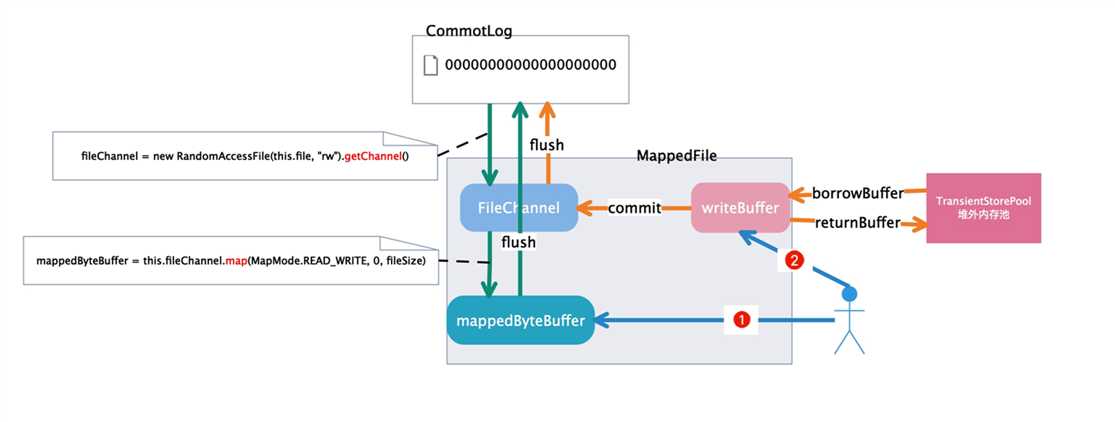标签:操作 存储器 位置 持久化 很多 处理 运算 tco 回收
RocketMQ存储中主要用到以下知识点:
mappedFile 对应着底层映射文件,主要的功能是
重要字段
public static final int OS_PAGE_SIZE = 1024 * 4;
protected static final Logger log = LoggerFactory.getLogger(LoggerName.STORE_LOGGER_NAME);
private static final AtomicLong TOTAL_MAPPED_VIRTUAL_MEMORY = new AtomicLong(0);
private static final AtomicInteger TOTAL_MAPPED_FILES = new AtomicInteger(0);
//加了 final,值不能修改
protected final AtomicInteger wrotePosition = new AtomicInteger(0);
//ADD BY ChenYang
// 先commit 后 flush
protected final AtomicInteger committedPosition = new AtomicInteger(0);
private final AtomicInteger flushedPosition = new AtomicInteger(0);
protected int fileSize;
protected FileChannel fileChannel;
/**
* Message will put to here first, and then reput to FileChannel if writeBuffer is not null.
* 消息先放到这里先,如果此时 writeBuffer 不为 null (此时有东西在写入)那么再次放入 fileChannel
*/
protected ByteBuffer writeBuffer = null;
//
protected TransientStorePool transientStorePool = null;
private String fileName;
private long fileFromOffset;
private File file;
//虚拟内存映射 buffer
private MappedByteBuffer mappedByteBuffer;
private volatile long storeTimestamp = 0;
private boolean firstCreateInQueue = false;
fileChannel 映射持久化的文件进来,使用原子类纪录 commit 和 flush 的节点。
init 方法
public void init(final String fileName, final int fileSize,
final TransientStorePool transientStorePool) throws IOException {
init(fileName, fileSize);
this.writeBuffer = transientStorePool.borrowBuffer();
this.transientStorePool = transientStorePool;
}
/**
* 初始化最主要就是文件映射
*/
private void init(final String fileName, final int fileSize) throws IOException {
this.fileName = fileName;
this.fileSize = fileSize;
this.file = new File(fileName);
this.fileFromOffset = Long.parseLong(this.file.getName());
boolean ok = false;
ensureDirOK(this.file.getParent());
try {
// RandomAccessFile
// 参见 : https://blog.csdn.net/qq496013218/article/details/69397380
this.fileChannel = new RandomAccessFile(this.file, "rw").getChannel();
// fileChannel.map 返回的是堆外内存(java.nio.directByteBuffer)
this.mappedByteBuffer = this.fileChannel.map(MapMode.READ_WRITE, 0, fileSize);
TOTAL_MAPPED_VIRTUAL_MEMORY.addAndGet(fileSize);
TOTAL_MAPPED_FILES.incrementAndGet();
ok = true;
} catch (FileNotFoundException e) {
log.error("create file channel " + this.fileName + " Failed. ", e);
throw e;
} catch (IOException e) {
log.error("map file " + this.fileName + " Failed. ", e);
throw e;
} finally {
if (!ok && this.fileChannel != null) {
this.fileChannel.close();
}
}
}
commit 操作。
/**
* 1. 判断是否达到commit 的要求
* 2. 获得锁
* 3. commit
* 4. 释放锁
*/
public int commit(final int commitLeastPages) {
if (writeBuffer == null) {
//no need to commit data to file channel, so just regard wrotePosition as committedPosition.
return this.wrotePosition.get();
}
if (this.isAbleToCommit(commitLeastPages)) {
if (this.hold()) {
commit0(commitLeastPages);
this.release();
} else {
log.warn("in commit, hold failed, commit offset = " + this.committedPosition.get());
}
}
//TODO 下面是什么操作
// All dirty data has been committed to FileChannel.
if (writeBuffer != null && this.transientStorePool != null && this.fileSize == this.committedPosition.get()) {
this.transientStorePool.returnBuffer(writeBuffer);
this.writeBuffer = null;
}
return this.committedPosition.get();
}
/**
* 使用 JAVA NIO 的 bytebuffer 创建子 buffer
* 然后写入到 filechannel 中去
* @param commitLeastPages
*/
protected void commit0(final int commitLeastPages) {
int writePos = this.wrotePosition.get();
int lastCommittedPosition = this.committedPosition.get();
if (writePos - this.committedPosition.get() > 0) {
try {
ByteBuffer byteBuffer = writeBuffer.slice();
byteBuffer.position(lastCommittedPosition);
byteBuffer.limit(writePos);
this.fileChannel.position(lastCommittedPosition);
this.fileChannel.write(byteBuffer);
this.committedPosition.set(writePos);
} catch (Throwable e) {
log.error("Error occurred when commit data to FileChannel.", e);
}
}
}
/**
* 判断是否满了或是达到了最小的 commit 页数
* @param commitLeastPages 最小commit 页数
* @return 是否可以 commit
*/
protected boolean isAbleToCommit(final int commitLeastPages) {
int flush = this.committedPosition.get();
int write = this.wrotePosition.get();
if (this.isFull()) {
return true;
}
if (commitLeastPages > 0) {
return ((write / OS_PAGE_SIZE) - (flush / OS_PAGE_SIZE)) >= commitLeastPages;
}
return write > flush;
}
FileChannel,MappedByteBuffer:
这两个类代表的是Mmap 这样的内存映射技术,Mmap 能够将文件直接映射到用户态的内存地址,使得对文件的操作不再是 write/read,而转化为直接对内存地址的操作。
Mmap技术本身也有局限性,也就是操作的文件大小不能太大,因此RocketMQ 中限制了单文件大小来避免这个问题。也就是那个filesize定为1G的原因。
flush 回刷到文件中去
/**
* @return The current flushed position
*/
public int flush(final int flushLeastPages) {
if (this.isAbleToFlush(flushLeastPages)) {
if (this.hold()) {
int value = getReadPosition();
try {
//我们只增加数据到 fileChannel 或是 mappedByteBuffer ,从不同时两者一起增加
//We only append data to fileChannel or mappedByteBuffer, never both.
if (writeBuffer != null || this.fileChannel.position() != 0) {
this.fileChannel.force(false);
} else {
this.mappedByteBuffer.force();
}
} catch (Throwable e) {
log.error("Error occurred when force data to disk.", e);
}
this.flushedPosition.set(value);
this.release();
} else {
log.warn("in flush, hold failed, flush offset = " + this.flushedPosition.get());
this.flushedPosition.set(getReadPosition());
}
}
return this.getFlushedPosition();
}
private boolean isAbleToFlush(final int flushLeastPages) {
int flush = this.flushedPosition.get();
int write = getReadPosition();
if (this.isFull()) {
return true;
}
if (flushLeastPages > 0) {
return ((write / OS_PAGE_SIZE) - (flush / OS_PAGE_SIZE)) >= flushLeastPages;
}
return write > flush;
}
其中 writebuffer 和 filechannel 什么情况会刷回磁盘呢?以下这种图回答了这个问题。

同时mappedFile还有预热处理,具体见 warmMappedFile 方法 。
该类的主要作用是创建内存池,而且是堆外内存,主要作用是消除了申请内存空间,回收的时间,提高了使用的性能。 字段
private final int poolSize;
private final int fileSize;
private final Deque<ByteBuffer> availableBuffers;
private final MessageStoreConfig storeConfig;
public class TransientStorePool {
private static final Logger log = LoggerFactory.getLogger(LoggerName.STORE_LOGGER_NAME);
private final int poolSize;//池的大小有多少,默认5
private final int fileSize;//每个commitLog文件大小,默认1G
private final Deque<ByteBuffer> availableBuffers;//双端队列记录可用的buffers
private final MessageStoreConfig storeConfig;//存储配置
public TransientStorePool(final MessageStoreConfig storeConfig) {
this.storeConfig = storeConfig;
this.poolSize = storeConfig.getTransientStorePoolSize();
this.fileSize = storeConfig.getMapedFileSizeCommitLog();
this.availableBuffers = new ConcurrentLinkedDeque<>();
}
/**
* It‘s a heavy init method.
* 初始化函数,分配poolSize个fileSize的堆外空间
*/
public void init() {
for (int i = 0; i < poolSize; i++) {
ByteBuffer byteBuffer = ByteBuffer.allocateDirect(fileSize);//虚拟机外内存中分配的空间
final long address = ((DirectBuffer) byteBuffer).address();
Pointer pointer = new Pointer(address);
LibC.INSTANCE.mlock(pointer, new NativeLong(fileSize));
availableBuffers.offer(byteBuffer);
}
}
//销毁availableBuffers中所有buffer数据
public void destroy() {
for (ByteBuffer byteBuffer : availableBuffers) {
final long address = ((DirectBuffer) byteBuffer).address();
Pointer pointer = new Pointer(address);
LibC.INSTANCE.munlock(pointer, new NativeLong(fileSize));
}
}
//用完了之后,返还一个buffer,对buffer数据进行清理
public void returnBuffer(ByteBuffer byteBuffer) {
byteBuffer.position(0);
byteBuffer.limit(fileSize);
this.availableBuffers.offerFirst(byteBuffer);
}
//借一个buffer出去
public ByteBuffer borrowBuffer() {
ByteBuffer buffer = availableBuffers.pollFirst();
if (availableBuffers.size() < poolSize * 0.4) {
log.warn("TransientStorePool only remain {} sheets.", availableBuffers.size());
}
return buffer;
}
//剩余可用的buffers数量
public int remainBufferNumbs() {
if (storeConfig.isTransientStorePoolEnable()) {
return availableBuffers.size();
}
return Integer.MAX_VALUE;
}
}
可以看到内存池在初始化的过程中,将内存用“lock”锁,防止CPU将进程在主存中的这一部分内存给交换回硬盘。
在netty的过程在使用过程中,也会使用内存池,内存池的优势是集中管理内存的分配和释放,同时提高分配和释放内存的性能,很多框架会先预先申请一大块内存,然后通过提供响应的分配 和释放接口来使用内存,这样系统的性能也会打打提高。
随机和顺序读写,是存储器的两种输入输出方式。存储的数据在磁盘中占据空间,对于一个新磁盘,操作系统会将数据文件依次写入磁盘,当有些数据被删除时,就会空出该数据原来占有的存储空间,时间长了,不断的写入、删除数据,就会产生很多零零散散的存储空间,就会造成一个较大的数据文件放在许多不连续的存贮空间上,读写些这部分数据时,就是随机读写,磁头要不断的调整磁道的位置,以在不同位置上的读写数据,相对于连续空间上的顺序读写,要耗时很多。 在开机时、启动大型程序时,电脑要读取大量小文件,而这些文件也不是连续存放的,也属于随机读取的范围。 随机读写:每一段数据有地址码,可以任意跳到某个地址读取该段数据 顺序读写:数据以一定长度连续存储,中间没有地址码,只能顺序读取
改善方法:做磁盘碎片整理,合并碎片文件,但随后还会再产生碎片造成磁盘读写性能下降,而且也解决不了小文件的随机存取的问题,这只是治标。更好的解决办法:更换电子硬盘(SSD),电子盘由于免除了机械硬盘的磁头运动,对于随机数据的读写极大的提高。 举个例子1: SSD的随机读取延迟只有零点几毫秒,而7200RPM的随机读取延迟有7毫秒左右,5400RPM硬盘更是高达9毫秒之多,体现在性能上就是开关机速度。
举个例子2:假设有1到1000笔的数据。 情况1:现在要读出第1000笔,顺序读写的方式是从第1笔开始读,一直找到第1000笔;随机读写是通过运算,很快的找到第1000笔。 情况2:要找出含“abc”的数据,顺序读写还是从第1笔开始读,一直找到第1000笔;随机读写是通过运算,很快的找到“abc”的数据。
本节介绍了rocketmq中的存储细节,包括 mmap 相关,内存池相关知识点。
标签:操作 存储器 位置 持久化 很多 处理 运算 tco 回收
原文地址:https://www.cnblogs.com/Benjious/p/11785942.html